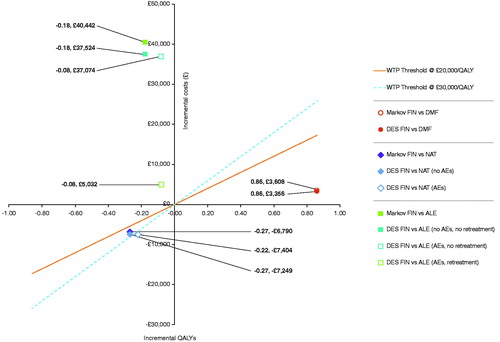Figures & data
Table 1. Summary of scenarios presented in the Markov and DES models.
Table 2. Cohort level characteristics of the IPD used.
Figure 1. The structures of the Markov and DES models. In the Markov model when patients are transferred to SPMS, their EDSS score increases by 1; this assumption was applied in the DES analyses to match the approach taken in both models. Note that in the models, it is possible for a patient to move between states that are more than one EDSS point apart. For example, a transfer from RRMS with EDSS score of 1 to EDSS score of 7 is possible, without going through all intermediate steps. The omission of these transition arrows is for the sake of clarity. Moreover, from each EDSS state patients can transfer to the death state.
Abbreviations. DES, discrete event simulation; EDSS, expanded disability status scale; QALYs, quality-adjusted life years; RRMS, relapsing-remitting multiple sclerosis; SPMS, secondary progressive multiple sclerosis.

Table 3. Efficacy inputs for the Markov and DES models.
Figure 2. Cost-effectiveness plane of deterministic results from comparison of DES and Markov models. All analyses were carried out with the intervention and comparators at their list price. A confidential PAS discount is available for fingolimod and DMF, this was not considered in the model. Values for each point are the incremental QALY and incremental cost for each comparison. Note: ‘No AEs’ indicates the removal of serious long-term AEs from the DES model which were not included in the Markov model (e.g. PML). ‘No retreatment’ indicates the removal of relapse-triggered retreatment for alemtuzumab in the DES model.
Abbreviations. AE, adverse events; ALE, alemtuzumab; DES, discrete event simulation; DMF, dimethyl fumarate; FIN, fingolimod; HA, highly active; ICER, incremental cost-effectiveness ratio; NAT, natalizumab; PML: progressive multifocal leukoencephalopathy; QALY, quality-adjusted life year; RES, rapidly evolving severe; RRMS, relapsing-remitting multiple sclerosis; WTP, willingness-to-pay.

